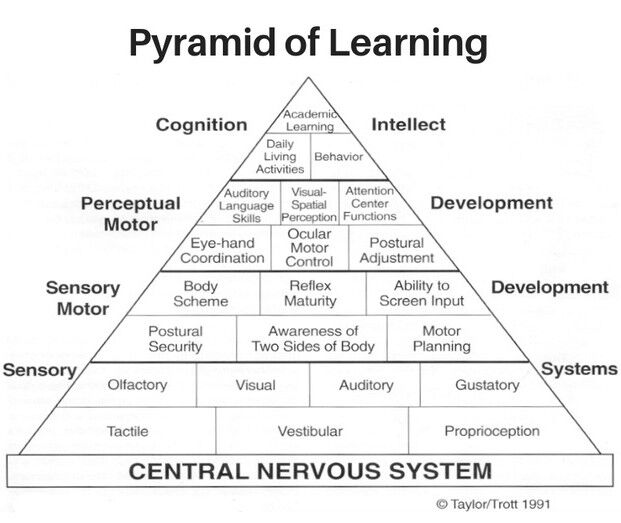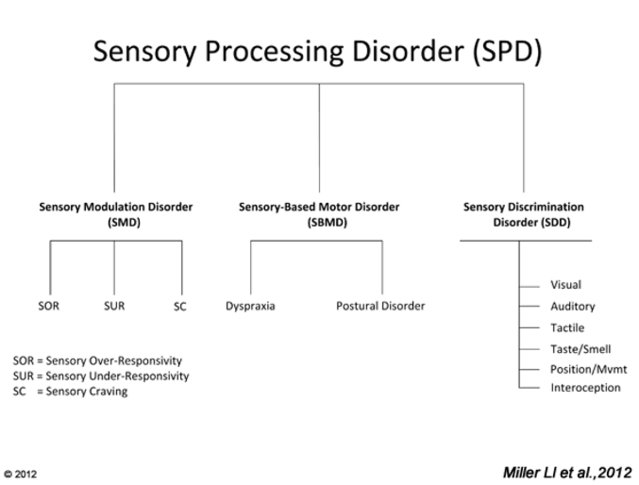ADHD
Homeschooling Your Child With ADHD in a Lockdown
Sensory processing strategies to maximise learning.
Posted June 28, 2020
It is estimated that 129 million children and adolescents worldwide have a diagnosis of Attention Deficit Hyperactivity Disorder (ADHD) (Thomas et al., 2015). In this current coronavirus pandemic, millions of children are being homeschooled by parents for the first time.
As a Paediatric Occupational Therapist and a mother of a child with ADHD, I thought it would be beneficial to offer some learning strategies, based on the sensory processing approach. Sensory processing lays down solid foundations for developing and mastering more complex skills needed for academic learning.

The Pyramid of Learning (Diagram 1: Taylor & Trott, 1991) is a child-centred model of how learning should develop. The foundation of successful learning is based upon an intact central nervous system and well-developed sensory systems. Without a firm foundation in place, the areas at the point of the pyramid, like academic learning, will not take place as successfully.
Sensory Processing
Inside Senses:
- Motion & balance (vestibular)
- Body position (proprioception: body awareness and movement of body)
- Interoception (identification of sensations/ feelings internally).
Outside Senses:
- Sight (visual)
- Hearing (auditory)
- Smell (olfactory)
- Taste (gustatory)
- Touch (tactile)
Dunn (2014) refers to neurological thresholds which can be either low or high. If a child responds very quickly to a sensory stimulus, they have a low threshold. Conversely, if a child responds too slowly, then they have a high threshold. To maintain optimum learning, children need to reach a balance between their thresholds, in order to notice enough to be aware and attentive, but not too much that they become overloaded with information and feel distracted.
Sensory Processing Disorders
Sensory processing difficulties can broadly present within the three following patterns: modulation, discrimination, or motor-based difficulties (Diagram 2).

Sensory Modulation:
Sensory modulation refers to the ability to filter out and make sense of the incoming sensory information. This could present as a child who has difficulty filtering out important information from the not important e.g. listening to their teacher’s verbal instructions from the chatter of children in the classroom.
Sensory Discrimination:
Sensory discrimination refers to the child’s ability to interpret, perceive and give real meaning to the sensation or stimulus that has been received. This may be reflected in a child that cannot discriminate between the different textures of materials, or the difference between hearing the words “cat” and “cap."
Motor-Based Sensory Difficulties:
Motor-based sensory difficulties include maintaining postural control and stability, balance, body awareness and motor planning. This could be seen by a child constantly moving, whilst sat at their desk, because their muscles around their core and back are not strong enough to maintain adequate sitting balance for prolonged periods.
Sensory Processing Strategy Approaches
Strategies for Vision:
From a visual perspective, there is a range of subtle adjustments that can be made to prevent visual sensitivity or distractibility.
- It may be worth experimenting with increasing the colour contrast on your child’s screen
- Or changing the lighting within the child’s room where they work the most
- Using a different font
- Increasing the type size
- Using coloured overlays (plastic transparencies) which are placed over the text to it make it stand out (coloured paper can also be used in the same way)
Strategies for Hearing:
Some children with ADHD suffer with sound sensitivity. This can be distracting for children e.g. in a busy classroom setting or during lockdown sat next to a sibling. Strategies can include:
Noise-cancelling earphones
The use of a metronome to play slower beats/rhythms (it can decrease hyperactivity and inattentive behaviours during handwriting tasks, for example)
Background classical music, which can also provide an organising effect on children and is often used in music therapy
Therapeutic listening, a sound-based intervention where the music is changed electronically so that it uses aspects of the sound spectrum to capture attention and activate body movement
Strategies for Touch and Taste:
Children with ADHD will often be seen fidgeting and frequently touching things.
- It is important to provide them with an appropriate fidget for their hands as this can be calming and regulating.
- If they cannot tolerate certain textures on their skin, consider letting your child sit barefoot and wear loose clothing.
- Oral input that is chewy and crunchy provides an organizing, regulating and calming effect.
- Chewing gum, dried fruit, or crunching on carrots provides this much-needed input.
Strategies for Smell:
Aqrabawi & Chul Kim (2018) found that information about space and time integrate within a region of the brain that is tied to our sense of smell. Therefore, when these factors combine, a ‘what-when-where’ memory is formed. They discovered that there is a neural pathway, which is critical for memory and contextual representation.
- Aromas such as rosemary are arousing and again linked to memory. Therefore, consider trialling a diffuser with rosemary essential oil.
Interoceptive Awareness:
According to Mahler (2019), a great deal of emerging research is shedding light on the importance of having a clear body-emotion experience to be able to self-regulate. Mahler’s Interoceptive Curriculum takes us through a series of valuable lessons that help bring about this awareness in self-regulating and connecting with our bodies, which those children with ADHD often miss.
Strategies for the Motion & Body Position:
These systems work together like a GPS system, and their inputs provide beneficial sensations that are organising and regulating. It is vital that children with ADHD have scheduled or regular "movement" breaks which are made up of gross motor activities or exercises. Movement breaks should never be used as part of a reward system.
It is important to schedule these movement breaks around your child’s learning. These create opportunities for the brain to have a rest and provide an alerting input which brings about the ability to re-focus and re-engage. Exercise changes the structure of our brains with several benefits including improved attention, cognitive functioning, enhanced mood, and ability to cope with stress:-
Movement break ideas:
- Using a jump rope
- Doing an obstacle course
- Jumping on a trampoline
- Jumping onto crash pads made up of cushions and mattresses at home
- Bouncing on a therapy ball, or lying on it, and rolling back and forth
- Etching a chalk sensorimotor pathway on the patio
- Doing yoga/pilates
- Jogging/running on the spot or outside
- Using a hula hoop
- Going for a bike ride
- Following a structured programme of movement, yoga and mindfulness videos, such as those provided by GoNoodle
- Whilst your child is sat at their desk, an exercise band or spandex can be placed around chair legs so that fidgety children they can push their feet into it, or place portable bicycle pedals under the desk for your child to peddle.
Parents can make the experience of homeschooling their child with ADHD more positive and empowering by building on their child’s successes and focusing on things they are good at. Typically, children with ADHD have wide-ranging positive characteristics like being energetic, spontaneous, inventive, creative and hyperfocused. Therefore, hone in on their best traits and use them to their advantage e.g. using their creativity and hyperfocus to create or build something related to a school project, instead of writing it down.
Children with ADHD can struggle with knowing how to execute what they have learnt. Therefore, it is vital to understand where their problems lie and find solution-focused ways to solve them. Emphasis needs to be placed on balancing how to manage a child’s behaviour with providing tangible rewards.
It is also ideal for there to be liberal praise and encouragement for attempts made, rather than negative consequences. Praise can improve concentration skills by up to 30 percent (Caldarella et al, 2020) if done correctly. It should be specific and focus on the effort made rather than the ability. This will not only increase concentration levels but, more importantly, improve your child’s self-esteem and confidence.
This post was guest-authored by Catriona Harrison-Harvey, Paediatric Occupational Therapist, Your Kids Therapy Ltd.
References
Aqrabawi, A.J, & Chul Kim, J. (2018). Hippocampal projections to the anterior olfactory nucleus differentially convey spatiotemporal information during episodic odour memory. Nature Communications, 9, 2735.
Caldarella, P., Larsen, R.A.A., Williams, L., Downs, K.R., Wills, H.P., & Wehby, J.H. (2020). Effects of teachers’ praise-to-reprimand ratios on elementary students’ on-task behaviour. Educational Psychology, 1 DOI: 10. 1080/01443410.2020.1711872
Dunn, W. (2014) Sensory Profile 2 – Strengths-Based Approach to Assessment and Planning. Bloomington, MN: USA. Pearson.
Mahler, K. (2019) The Interoception Curriculum. USA. www.kelly-mahler.com
Miller, L. J., Anzalone, M. E., Lane, S. J., Cermak, S. A., & Osten, E. T. (2012). Concept evolution in sensory integration: A proposed nosology for diagnosis. American Journal of Occupational Therapy, 61(2), 135-140. doi:10.5014/ajot.61.2.135
Taylor, K & Trott, M (1991) in Williams, S. and Shellenberger, S. (Eds.) (1994) How does your engine run? Albuquerque, NM. Therapyworks.
Thomas, R., Sanders, S., Doust, J., Beller, E. and Glasziou, P. (2015). Prevalence of Attention-Deficit/ Hyperactivity Disorder: A Systematic Review and Meta-analysis. Paediatrics, 135 (4), pp. e994-1001.




